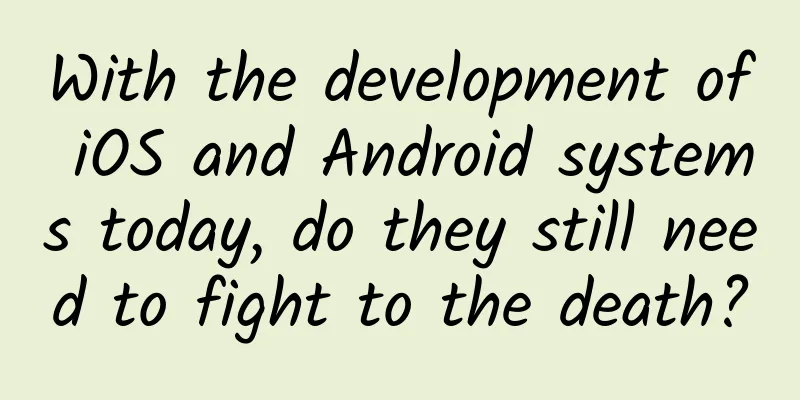With the development of iOS and Android systems today, do they still need to fight to the death?

|
In the first half of this year, Apple and Google both released the latest iOS and Android systems. Both talked about the current problem of mobile phone addiction and refurbished the system's built-in applications such as photo albums and news. As for the two hot fields of AI and AR, the giants will naturally not let them go. If you have watched these two conferences and really experienced iOS 12 and Android P systems, you will inevitably have a question: Are iOS and Android too similar now? The most obvious solution is the problem of digital addiction. Both Apple and Google provide software in their systems for counting the frequency and duration of daily mobile phone use. You can see in detail the frequency and number of times you wake up your phone every day, the number of push notifications from various apps, etc. At the same time, you can also set usage time periods for a single type of app, such as prohibiting the opening of WeChat and Weibo before going to bed at night, so as to reduce the time you rely on your phone. I don’t know whether Apple and Google had discussed this feature privately before developing it, nor do I care whether the problem of “mobile phone addiction” is as serious as Silicon Valley practitioners say. But what is clear is that the two companies have stood on a united front this time and have chosen the same solution, probably due to some kind of tacit understanding. Another common trend is reflected in the visual presentation and interaction system of the two interfaces. If we take iOS 7 and Google's Material Design as a dividing point, iOS and Android have been on the road of flat style for 4-5 years. There are more and more interfaces with frosted glass effects, large blocks of color on white backgrounds, and rounded corners, and there is no sign of turning back or turning around. Although this general shift in direction was met with a lot of skepticism when skeuomorphism was first eliminated, with the change in aesthetic concepts, more and more people recognize this visual design that is simple, light, easier to understand, and highlights the content and information itself. Flatness has become the mainstream design of smartphone systems. As for gesture interaction, in the era of full-screen phones, mobile phone manufacturers are trying every means to eliminate physical buttons and develop towards an integrated form as much as possible. Therefore, multi-layer vibration feedback is used to simulate the physical pressing touch, and new components such as structured light are used to replace the old fingerprint module. These hardware-level changes have made the introduction of gesture interaction in iOS and Android a very natural development trend. On last year's iPhone X, Apple tried for the first time to remove the physical Home button on the front, and replaced the original tapping operation with gestures such as swiping up and swiping sideways from the bottom. This year, this set of gestures has been further integrated into the iPad. Maybe the Home button will also be removed on the new iPad in September. The situation is similar in the Android camp. Long before Android P, various gesture operations had been "legitimately" added to most domestic flagship phones. On a larger level, such as the integration of mobile and desktop application ecosystems, and trying to integrate AR technology into more mobile devices, iOS and Android have the same goals in these matters. Today, the two systems are probably more similar than they are different. This high degree of "consistency" that can be felt on different platforms once again brings up a point of view from previous years: Apple and Google are doing very similar things. In other words, they have chosen the same development direction. Of course, it is difficult to say who copied whom based on the similarity in functional points. After more than 10 years of development, the cross-complementary borrowing between iOS and Android has long been an open secret. Moreover, such new functions are not gimmicky features, and consumers are also happy to see such integration. On the other hand, as large companies, Apple and Google no longer describe grand visions, nor do they deliberately seek to significantly outperform their competitors. Their current attitudes towards iOS and Android are actually to seek a certain "comfort" in the user experience - it can't be said to be boring, but it feels more like stability is the first priority, and they are more cautious about some new features with higher risks. The decision to "maintain the status quo" may be related to the overall market environment. According to Gartner's statistics and Statista's charts in 2017, Android's market share has reached 85.9%, while iOS's is 14%. Together, they account for 99.9% of the global smartphone market. As for other systems such as BlackBerry or Windows Phone, they only account for 0.1% in total, which can be basically ignored. In other words, the user scale of Apple's iOS and Google's Android systems is already sufficient to support their ecosystems and business models. In addition, it is already difficult to tap into new users in the current smartphone market, so it is difficult for Apple or Google to expect to achieve large-scale growth again - at least not by relying on smartphones. At this stage, the mobile phone system is already perfect in terms of both function and ecology. Users have fewer and fewer complaints about the system. If it is good enough, they are reluctant to change their phones. Naturally, they hope that their phones can be supported for a longer period of time. Therefore, any major changes or aggressiveness of iOS and Android will break this optimal state. ▲Image from: Lifewire Two years ago, analyst Benedict Evans also put forward a point of view. He said that after the user scale stabilizes, American bank managers will not care how many Android users there are in China, and Indian product managers will not care how many iPhone users there are in the United States. Rather than competing for a few tenths of market share in the future, what is more critical is what existing users can bring to Google? And how can Apple ensure that its iPhone users will not defect to other brands? ▲Image from: Wired Today, Google’s development goals are very clear. When Android’s user experience has basically caught up with iOS, Google chose to shift from mobile first to AI first. The huge Android user data can also strengthen Google’s advantage in machine learning. Now AI has gradually penetrated into multiple native Android applications including photography, photo albums, maps and voice assistants. As long as Google can obtain more and more data, its AI applications will continue to evolve and improve themselves. Apple has adopted a different approach. On the one hand, devices such as Apple Watch, AirPods and HomePod can only be used in Apple's own ecosystem to obtain the best experience, in order to prevent competitors from snatching its most valuable core user base. This allows Apple to ensure that all its core iPhone users continue to stay in the iOS ecosystem as much as possible, while also attracting some Android users. On the other hand, Apple hopes that every iOS user will use more Apple devices and services - whether it is a computer tablet, a watch or headphones, or even content such as music or TV shows. As long as existing users are willing to pay more, they will bring sustainable revenue to Apple. ▲Image from: CNET This year's iOS 12 is also very clear in this regard. Apple has chosen to slow down the major upgrades of iOS and prioritize maintaining its old users in order to ensure this overall "comfort". Although Apple will still target high-end Android users, the desire to poach them is no longer as strong as before. The only thing it can do is to mock the fragmented Android with a higher iOS system update rate, but it is difficult for Android users to have a good impression of the iPhone because of this. Therefore, as long as Apple and Google do not make any big mistakes and continue to lead in technology, even if they cannot develop further, others will not have any loopholes to exploit, and the duopoly will continue. This is the current situation that smartphones have developed to the present, and it is difficult to change. Perhaps, the platform competition is no longer limited to the mobile phone level, but that is a story in another field. |
<<: A programmer's career roadmap worth paying attention to to help you clear the fog
>>: Some thoughts on Android APP performance optimization
Recommend
How to turn off the WeChat mini program function? How to log out of WeChat Mini Program?
How to turn off the WeChat mini program function?...
My child has a big head and short limbs. Could he be suffering from achondroplasia?
《Cotton Swab Medical Science Popularization》 Yong...
The tremendous power of B2B operations, from building a value chain to humanizing the carrying system!
After all fields of B2C have entered the red ocea...
How to apply the addiction model in activity design of game products?
Recently, one of the team's stage goals for p...
A 2,000 yuan and 4,000 yuan phone has the same processor, but the price is half the difference! Where did the latter spend the money?
I don’t know if you have noticed that in recent y...
To prevent artificial intelligence from betraying humanity, Google, Microsoft and other giants are determined to work together
From "2001: A Space Odyssey" to "T...
Anhui She County starts using the college entrance examination backup papers today
Anhui Shexian County uses the backup papers for t...
Do you really know how to leverage brand marketing?
Many brands are accustomed to using the marketing...
Oil spill, why donate hair?
In the long history of the evolution of life on E...
Wearable devices are rapidly penetrating the enterprise market, and changes are inevitable
On December 15, according to foreign media report...
WOT2016 Wang Qingyou: Listen to the Chief Architect Discussing Large APP Server Architecture
The WOT2016 Mobile Internet Technology Summit wil...
How to effectively deliver short video information flow?
This article mainly introduces the preparations b...
The Cambridge History of China (Chinese Edition, 11 Volumes) PDF Scanned Version Baidu Cloud Download
The Cambridge History of China (Chinese Edition, ...
The latest Baidu answering project, automatic question grabbing + question search, Xiaobai earns 500+ a day
The latest Baidu answering project, automatic que...
GITC 2014: Elites gather to soar to the sky
[[120831]] In recent years, with the support of n...









